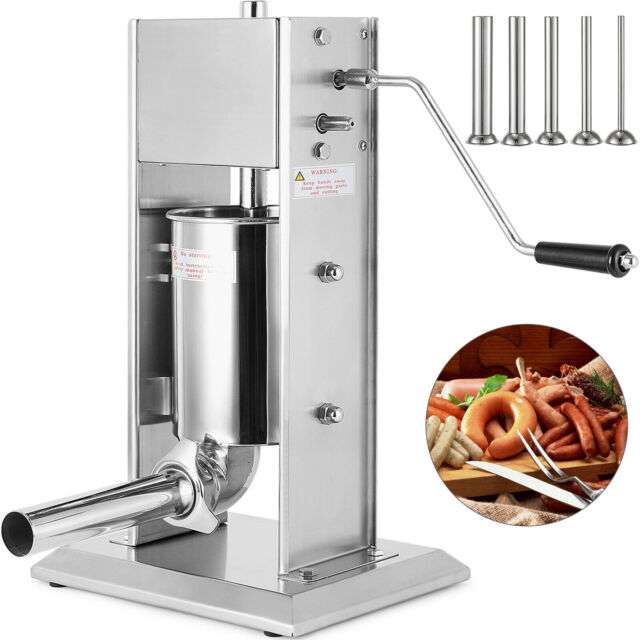Introduction of Sausage Filler
Sausage fillers are essential machinery in the meat processing industry, yet their significance often goes unrecognized. These machines are crucial for creating the diverse range of sausages that populate our tables, from common varieties like frankfurters to more specialized ones like chorizo. Understanding the basic components and functions of sausage fillers is key to appreciating their vital role in the sausage-making process.
The Core Function of Sausage Fillers
Mechanical Marvels for Sausage Production
At its essence, a sausage filler is a mechanical device that fills casings with a blend of meat, fat, and seasonings to create uniform sausages. The process begins with meticulously preparing the sausage meat, which involves mincing, emulsifying, and seasoning the ingredients to achieve the desired texture and flavor. This prepared meat is then loaded into the first key component of the sausage filler—the hopper.
The Role of the Hopper
A Reservoir for Sausage Meat
The hopper acts as a reservoir, holding the sausage meat until it is ready for filling. Its design is crucial, as it must accommodate large quantities of meat while ensuring an even distribution during the filling process. The efficient functioning of the hopper directly influences the quality of the sausages produced.
The Stuffing Head: The Heart of Sausage Filler
Shaping and Filling Casings
After leaving the hopper, the sausage meat travels through a series of tubes and nozzles collectively known as the stuffing head. This component is the heart of the sausage filler, responsible for shaping and filling the casings. The nozzles within the stuffing head are adjustable, allowing the production of sausages in various diameters and shapes, catering to a wide range of preferences.
The Stuffer: Ensuring Quality and Consistency
Pushing Meat into the Casings
As the meat passes through the stuffing head, it encounters the stuffer, another critical component of the sausage filler. The stuffer, typically a piston or rotating auger, pushes the meat into the casing. The design and speed of the stuffer are vital for ensuring that the sausage is filled evenly and without air pockets, which could compromise the quality of the final product.
Final Touches of Sausage Filler
Completing the Sausage-Making Process
Once the casing is filled, the sausage is linked or twisted into the desired lengths, with any excess trimmed away. The linked sausages are then hung to mature, a crucial step that allows the flavors to develop fully and the sausages to firm up, ready for consumption.
Versatility in Sausage Fillers
Catering to Different Scales of Production
Sausage fillers come in various sizes and configurations, making them suitable for both small-scale butcheries and large-scale factories. While some models are manually operated, others are fully automated, capable of producing thousands of sausages per hour. Despite the differences in size and complexity, all sausage fillers operate on the same basic principles, making them indispensable in the meat processing industry.
Conclusion of Sausage Filler
Sausage fillers are not just machines; they are the backbone of sausage production. By consistently filling casings with a perfectly balanced mixture of meat, fat, and seasonings, these machines ensure the large-scale production of high-quality sausages. Understanding their components and functions offers valuable insights into the intricacies of meat processing and highlights the essential role these fillers play in our culinary experiences.
Sausage Fillers FAQ Summary
1.What is a sausage filler?
It is a mechanical device used in the meat processing industry to fill casings with a mixture of meat, fat, and seasonings to create sausages.
2.How does a sausage stuffer work?
The process starts with preparing the sausage meat, which is then loaded into a hopper. From the hopper, the meat is pushed through a stuffing head, where it is shaped and filled into casings by a component called the stuffer. The filled sausages are then linked, trimmed, and hung to mature.
3.What is the function of the hopper in a sausage stuffer?
The hopper acts as a reservoir, holding the sausage meat and ensuring its even distribution during the filling process.
4.What is the stuffing head, and why is it important?
The stuffing head is the core component of a sausage filler, responsible for shaping the sausage meat and filling the casings. It contains adjustable nozzles that allow for different sausage sizes and shapes.
5.What role does the stuffer play in sausage filling?
The stuffer, usually a piston or rotating auger, pushes the sausage meat into the casing. It is crucial for ensuring the sausage is filled evenly and without air pockets, which can affect the quality.
6.Are there different types of sausage stuffers?
Yes, sausage stuffers come in various sizes and configurations, from manual models used in small butcheries to fully automated machines in large factories.
7.Why are sausage fillers essential in the meat processing industry?
Sausage fillers enable the efficient and consistent production of high-quality sausages on a large scale, making them indispensable in the industry.
8.What happens after the sausage is filled?
After filling, sausages are linked, trimmed, and hung to mature, allowing flavors to develop and the sausages to firm up for consumption.

